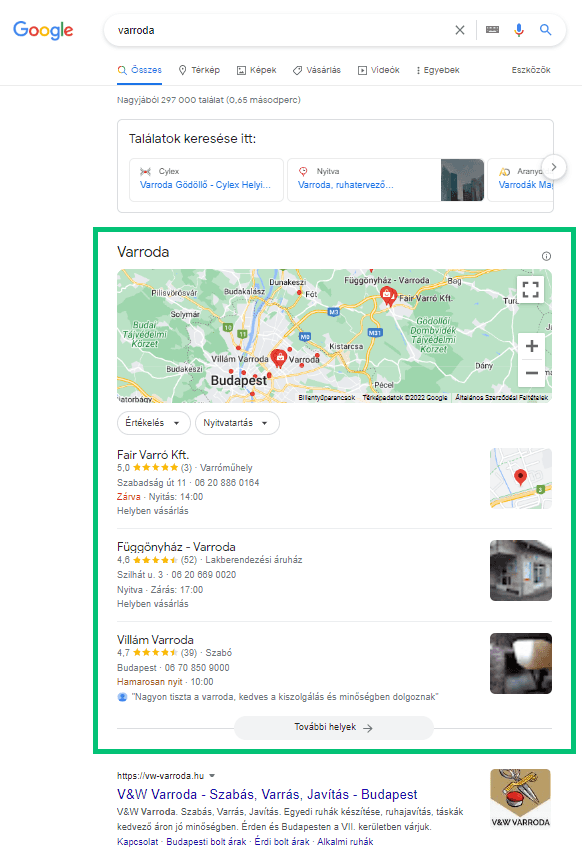What is search engine optimization, or SEO?
A keresőoptimalizálás mindazokat a tevékenységeket jelenti, amelyekkel javítjuk a webhely minőségét:
- minőségi tartalmakat publikálunk, amelyeket
- könnyen megtalálhatóvá és feltérképezhetővé teszünk a keresők (mind a keresőrobotok, mind a kereső emberek) számára.
A keresőoptimalizálás célja a Google és más keresőmotorok találati listájának élére kerülés, hogy minél többen találják meg a webhelyet.
A SEO-nak klasszikusan három területét szokás megkülönböztetni: technikai SEO, on-page SEO és off-page SEO.
Ehhez jön negyediknek a helyi SEO (local SEO).
SEO is classically divided into three areas: technical SEO, on-page SEO and off-page SEO.
On-page SEO
On-page SEO is the optimization of content, i.e. writing, editing and maintaining it.
Quality content is the key to ranking in search engines. The pages of a website are found in Google and other search engines based on their content. Visitors decide if a web page is valuable based on its content: whether they gain something from it, whether it is worth staying on, whether it is worth visiting more pages of the website, and whether it is worth returning to the site later.
If content is poorly written, it'll have a hard time ranking on the first pages of Google, even if the website is fully technically optimized and the SEO settings are perfect. At least, if you have major competitors, if you don't just want to get your brand name in front, or if you don't have unlimited amounts of money to spend on advertising.
Besides creating quality content, it's also important to upload it in an optimized way: as it is the easiest for robots to crawl and understand.
Technical SEO
Technical search engine optimization refers to the quality of the technical background of a website. It means:
- the quality of the website development, the coding,
- the technologies applied in development and how they are used, and
- the quality and performance of the hosting server.
The quality of technical design can affect not only rankings, but also advertising costs.
With content management systems-based websites, certain technical SEO settings can be performed by the website managers (editors, content uploaders, content managers), in a user-friendly interface, i.e. without coding.
They can, for example, edit and optimize the site map, the page title and meta description elements in the HTML <head> section, the redirects, etc.
Off-page SEO
Off-page SEO refers to the promotion of a website through link acquisition or other channels.
Link building is offered as a service by many providers.
However, the safest, most profitable, long-lasting and self-sustaining method of link building is to write and produce quality content that visitors find valuable, interesting and useful, therefore genuinely want to share, reference and link to it in their own content as a resource.
+1: Local SEO
Local businesses' customers, clients and guests come from a relatively narrow geographical area, typically a city. For bakeries, key shops, cake shops, hairdressers, etc., the main means of attracting customers is not necessarily a website and content marketing that requires a significant investment of time and/or money.
They may want, at least in the first instance, to use their Google My Business profiles to maximise visibility on Google Maps and in map results.

Quality posts both on Google My Business and on social media also help a lot to increase visibility, build trust, strengthen and expand the local customer community.
For local businesses that outgrew these platforms, or if those that have the capacity to maintain it, having their own website is the logical next step!
Technikai SEO
A technikai keresőoptimalizáltság a webhely technikai hátterének kialakítását és megjelenítésének minőségét jelenti:
- a webhely fejlesztési munkálatainak, a kódolásnak a minőségén,
- a fejlesztés során alkalmazott technológiák korszerűségén és felhasználásának módján, illetve
- a tárhely minőségén és teljesítményén múlik.
A technikai felépítés minősége nemcsak a rangsorolásra lehet hatással, hanem a hirdetési költségekre is.
Bizonyos technikai SEO-beállításokat a tartalomkezelő rendszereken alapuló website-ok kezelői (szerkesztői, tartalomfeltöltői, tartalommenedzserei) maguk is el tudnak végezni egy felhasználóbarát felületen, tehát kódolás nélkül.
Így például tudják szerkeszteni, optimalizálni a webhelytérképet, a HTML <head> részében levő page title és meta description elemeket, az átirányításokat stb.
Off-page SEO
Az off-page SEO a weboldal linkszerzésen vagy más csatornákon keresztüli népszerűsítését jelenti.
A linképítés szolgáltatásként is sok helyen igénybe vehető.
Ám a linkszerzésre a legbiztonságosabb, legjobban megtérülő, hosszútávon kamatozó és önműködő módszer az, ha minőségi tartalmakat írunk, készítünk.
Azokat a tartalmakat, amelyeket a látogatók értékesnek, érdekesnek, hasznosnak találnak, maguktól is szívesen megosztják, forrásként említik, és linkelnek rájuk a saját tartalmaikban.
+1: Helyi SEO (Local SEO)
A helyi vállalkozásoknak az ügyfelei, vásárlói, vendégei egy szűkebb földrajzi területről, tipikusan egy településen belülről kerülnek ki.
A pékségeknek, a kulcsmásolóknak, a cukrászdáknak, a fodrászszalonoknak stb. nem feltétlenül a saját weboldalon kivitelezett, jelentős idő- és/vagy anyagi befektetést igénylő tartalommarketing a fő eszközük a vevőszerzéshez.
Nekik célszerű lehet, legalábbis első körben, a Google Cégem profiljukat maximális hatékonysággal használni, hogy minél láthatóbbak legyenek a Google Térképen és a Google térképes találatai között.
Mind a Google Cégemben, mind a közösségi médiában közzétett minőségi posztok is sokat segítenek az ismertség növelésében, a bizalomépítésben, a helyi vásárlóközösség megerősítésében és bővítésében.
Ha ezeket kinövik, illetve ha van kapacitás, akkor persze mindig jó a saját webhely is!
